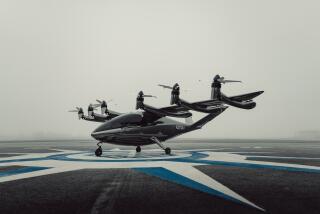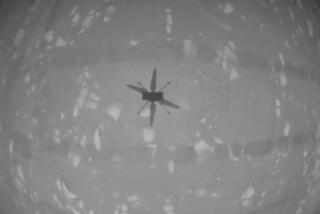Copter’s Crew Pins Hopes on Pedal Power
- Share via
A small knot of students screamed encouragement as Andres Eulate pedaled as fast as he could.
“Pump! Pump! Faster!” yelled the aeronautical engineering students from Cal Poly San Luis Obispo.
Eulate, 20, was seated in a weird looking whirlybird called the Da Vinci II. His cockpit was a triangular shaped cage at the center of two 3-foot-wide lightweight rotor blades with a total wingspan of 140 feet.
The students were trying to make a dream of Leonardo da Vinci come true in a Long Beach hangar.
Nearly 500 years ago, Leonardo, in one of his sketch books, depicted two men turning a crank enabling them to lift off the ground in a craft that vaguely resembles a modern-day helicopter.
For seven years Cal Poly students have been trying to achieve what hitherto has been the impossible--flying a human-powered helicopter.
Eyes on the Prize
They are not alone. Other groups in the United States, England and Japan are attempting the same feat, in a bid to win the American Helicopter Society’s $25,000 prize for the first successful flight.
Rules stipulate that the craft lift and hover at least 10 feet off the ground for 60 seconds without drifting more than 15 feet in any direction.
Da Vinci II’s pilot, a top-flight bike racer, is 5-feet-9 and weighs 137 pounds, about the same weight as the foam, graphite, plastic covered rotor. Lightweight propellers are at the end of each rotor blade.
“They call me HPU--the human power unit. They selected me because I don’t weigh much and I’m a fast pedaller,” said Eulate. He keeps in training riding his bike at least 300 miles a week.
“It isn’t easy trying to fly this thing. It’s awkward. It’s a jerky type pedaling. I try my best, but so far we haven’t got it airborne. But we’re convinced one of these days it will lift off the ground.”
Hooked to the pedals on an elliptically shaped takeoff spool is polyethylene thread that has been fed through the rotor blades and attached to the propellers. Eulate’s pedaling motion has the same effect as spinning a top, only he’s spinning propellers.
A student at each end of the rotor pushes the blades to give them initial momentum as Eulate pumps.
In Theory, It Flies
“Theory has it the Da Vinci II should become airborne at 6 r.p.m., which has been achieved a couple of times, but still it did not lift off,” said William B. Patterson, mechanical engineering professor and faculty adviser for the project since it started in 1981. “Students keep redesigning this part and that part,” he said, but “there are so many unknowns.”
“We feel we are getting very close. We are going to fly Da Vinci II. It’s just a matter of time,” insists Jim Freitas, 23, president of the 30-member Cal Poly American Helicopter Society Chapter. Freitas and several students have been spending about 40 hours a week redesigning and testing the craft.
In many tests, such as several conducted last weekend inside the biggest building in Southern California, the rotor blades have crashed to the ground, breaking propellers and ripping sections that the students quickly replace or repair.
The test site lately has been in the McDonnell Douglas 780-foot wide, 1,054-foot long, 100-foot high hangar soon to be used to manufacture the Air Force’s new C-17 cargo airplanes.
Wind Is a Threat
“One of our problems is finding a building big enough for testing,” explains Rob Faye, 26, past president of the student club and now aeronautical engineer with McDonnell Douglas Helicopters in Mesa, Ariz. Like many students who worked on the project in past years, he has graduated but continues with the effort in his free time.
“We do all our testing inside because the Da Vinci II is so fragile the slightest gust of wind would rip it apart,” Faye said.
The Da Vinci I, the first human-powered helicopter designed and built by the students, had a much smaller rotor and was much heavier.
Several companies have donated more than $50,000 worth of materials to construct the craft.
Cal Poly San Luis Obispo’s aeronautical engineering school started in 1927, and is one of the oldest in the nation. In 1927-28, the school constructed and flew the first airplane ever built by students in America. It was a replica of Lindbergh’s Spirit of St. Louis.
Among the school’s graduates have been Astronaut Robert (Hoot) Gibson, commander for the Space Shuttle Mission 24, and Burt Rutan, designer of the Voyager.
More to Read
Sign up for Essential California
The most important California stories and recommendations in your inbox every morning.
You may occasionally receive promotional content from the Los Angeles Times.










